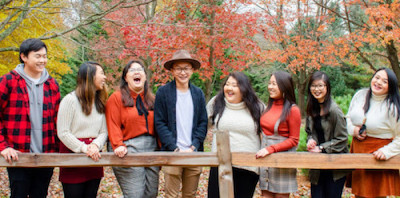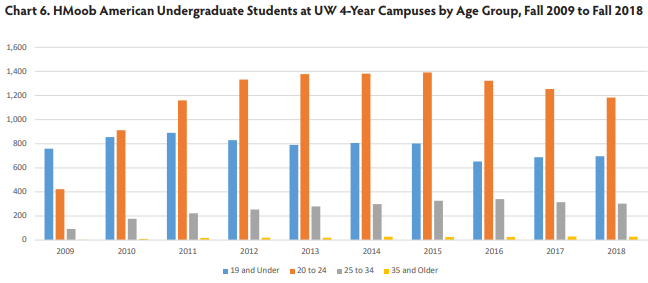By Janet L. Kelly, WCER Communications
A team of HMoob (Hmong)* American undergraduates mentored by UW-Madison education researchers has completed the first analysis of University of Wisconsin System student data disaggregated by race and ethnicity for the state’s largest Asian ethnic population. The team finds that except for UW–Oshkosh and UW–Green Bay, UW System enrollment of HMoob Americans is proportionally low and declining, particularly at the state’s flagship UW–Madison campus.
A report describing the study states that overall HMoob American students continue to face challenges in completing college degrees and proposes recommendations for how the state’s 13 four-year public universities can better serve this student population. The report is co-authored by Bailey Smolarek, MaiNeng Vang, and Matthew Wolfgram from the Center for Research on College-Workforce Transitions (CCWT), a project of the Wisconsin Center for Education Research within UW–Madison’s School of Education.

“The analysis indicates that 80 percent of UW System HMoob American students are the first in their families to attend college,” states Smolarek, who notes that the same percentage also receive Pell Grants, an indication of high financial need for students.
“Moreover, based on the available data of new freshman students, the six-year graduation rate of HMoob American students for the years 2009 through 2012 is significantly lower than that of other students, at 46 percent compared to 62 percent.”
Members of the historically displaced HMoob people began immigrating to Wisconsin as refugees in 1975 and continued through 2006. However, Smolarek notes it was only in 2006 for UW–Madison, and 2008 for the rest of the UW System schools, that students could select “Hmong” as their ethnicity on university enrollment applications. Before that, HMoob American students in the UW System were categorized as “Asian,” “Southeast Asian,” or “Targeted Minority.”
Among the recommendations, the researchers call for Wisconsin state universities and colleges to disaggregate their enrollment data and publicly disclose the educational statistics of their HMoob American students. They also recommend increasing recruitment efforts and support programs to better meet the educational needs of HMoob American students, as well as introducing programs in HMoob American studies to better educate Wisconsinites about the history and culture of the HMoob.
In support of these recommendations, the HMoob American undergraduate research team has been conducting qualitative research on the UW-Madison campus to better understand the social and institutional factors that influence campus inclusion, educational success, and post-college transitions of HMoob American undergraduate students. The researchers are interviewing current HMoob American students, as well as alumni, students who transferred or left UW, and UW staff who work with this student population.
In addition to student analysis within the UW System, the report also details that Wisconsin ranks third for the most HMoob residents in the U.S., surpassed only by California and Minnesota. In Wisconsin, Milwaukee County has by far the largest number of HMoob residents, followed by Dane and Marathon counties.
Though an accurate estimate of the state’s overall HMoob populations will not be available until the 2020 U.S. Census is completed, the American Community Survey estimates the number of HMoob residents in the state at 55,000 in 2015, while the 2010 U.S. Census recorded Wisconsin’s total population at 5.7 million people.
* While both spellings are pronounced the same, the research team uses the spelling “HMoob,” in place of “Hmong,” throughout its work to acknowledge and include the many dialects of the language, and avoid its Americanized spelling. The spelling, based on the Hmoob Roman Popular Alphabet, includes the use of a capitals H and M (HMoob) and is intended to include the ethnicities that spell their names with an “H” or “M,” such as Hmong Der or Mong Leng.
